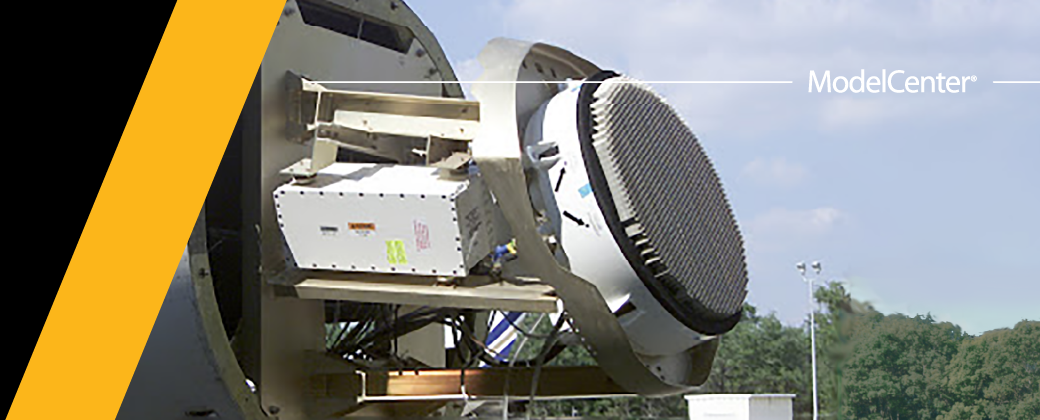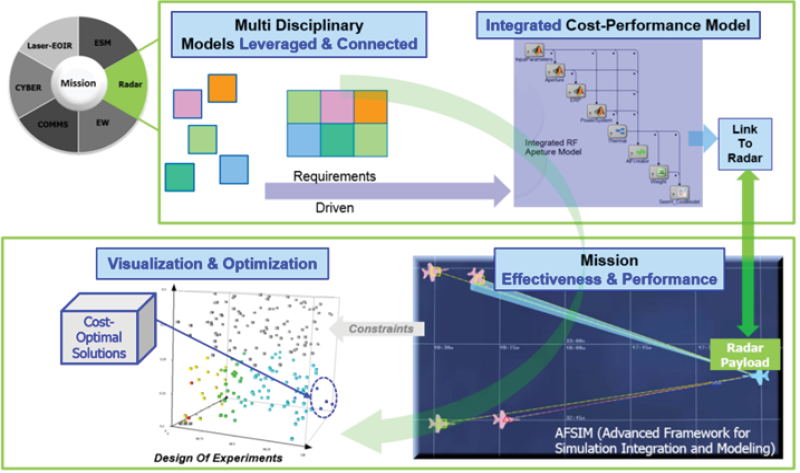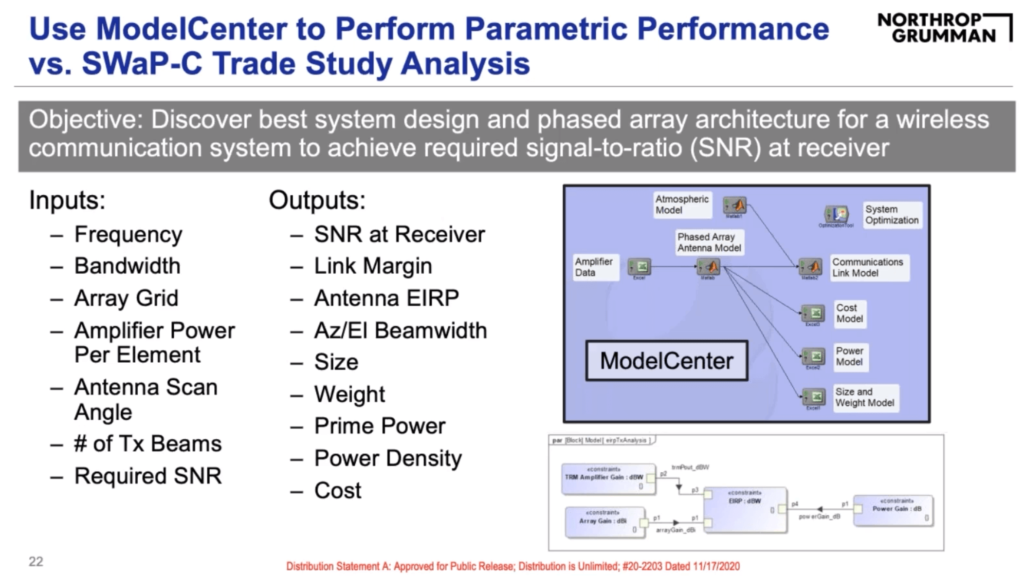Northrop Grumman Corp. applied Model-Based Systems Engineering (MBSE) and Multidisciplinary Analysis and Optimization (MDAO) to the development of Phased Array Antenna Models to Improve Design Time and Quality

Executive Summary
- Industry: Aerospace
- Products: ModelCenter MBSE , ModelCenter Integrate , ModelCenter Explore
- Applications: MBE: Model Based Engineering , MBSE: Model Based Systems Engineering , MDAO: Multi-Disciplinary Analysis and Optimization
Northrop Grumman Corp. applied Model-Based Systems Engineering (MBSE) and Multidisciplinary Analysis and Optimization (MDAO) to the development of Phased Array Antenna Models to Improve Design Time and Quality
The United States Department of Defense (DOD) distributed a report in 2018, Digital Engineering Strategy. “Current acquisition processes and engineering methods hinder meeting the demands of exponential technology growth, complexity, and access to information.” The report continues with, “To help ensure continued U.S. technological superiority, the Department is transforming its engineering practices to digital engineering, incorporating technological innovations into an integrated, digital, model-based approach.”
To meet the demand of the DOD, Northrop Grumman has begun implementing an integrated, model-based approach to the way they develop phased array antenna sensor systems. Phased array antenna sensors are essential to all types of wireless communication, radar, and electronic warfare. Due to the wide variety of uses, multifunctionality, and applications of these devices, they have become more complex to design and test.
Previously, Northrop’s descriptive architecture models and analytical models were in separate domains and heavily relied on documents, spreadsheets, performance rollups, and used clean sheet designs. It lacked digital integration and suffered from human error and slow turnaround. Northrop Grumman developed an integrated model-based systems engineering (MBSE) approach to designing and optimizing phased arrays to solve these issues. However, they needed a tool to connect their multi-domain, physics-based analysis and workflows to systems architecture models; this is where ModelCenter came in.
| Watch Webinar |
|
May 13, 2021 |
Background
“… the legacy acquisition engineering processes are document-intensive and stove-piped, which often leads to enhanced cycle times with systems that are cumbersome to change and sustain. Additionally, the DOD faces the challenge of balancing design, delivery, and sustainment of complex systems with rapidly changing operational and threat environments, tight budgets, and aggressive schedules. These current acquisition processes and engineering methods hinder the demands of exponential technology growth, complexity, and access to information.” – The US Department of Defense’s 2018 ”Digital Engineering Strategy“ report.
Phased Array Antennas are typically designed for a specific purpose to fit a certain system or a particular mission while maintaining definitive constraints. The traditional methods at Northrop performed antenna component simulations separate from the descriptive model. Northrop handled communicating simulation results to the descriptive models through face-to-face interactions, phone calls, or emails, which were difficult, time-consuming, and prone to errors. One decision could take several days to resolve, primarily because of communication delay.
Challenge
Northrop needed to reevaluate and redevelop the way requirements were communicated to analysis to reduce the document-intensive engineering process.
- Automate and integrate the individual engineering disciplines into one workflow
- Use integrated workflow to run a multitude of trade studies to locate the optimal design
- Connect systems requirements to automated workflows to calculate performance, check requirements, and perform design trade-offs studies.

Graphic courtesy of Northrop Grumman
Customer Objectives:
- Reduce errors of communicating requirements and analysis results
- Reduce time to reach the optimal design
- Attract more programs and win contracts

“What ... gets me most excited is MDAO, which is calculating system performance, checking requirements, and performing design trade-offs in a very quantitative fashion. We have a flexible model for evaluating trade studies, performing system optimization, and system verification for phased array antenna systems.”
Solution
Northrop Grumman needed a solution to improve their engineering workflows that content physics-based analysis to the systems requirements. The first step was to connect the analysis models from different disciplines together to create modular building blocks. Next, create a streamlined connection from the systems architecture models (SAM) to engineering analysis. ModelCenter® Integrate automated the workflows, while ModelCenter® MBSE connected these workflows to the SysML (SAM) models.
The fully integrated system can calculate performance, check requirements, and perform design trade-offs using ModelCenter® Explore. Northrop can run thousands of use cases to develop Pareto Front of cost verse performance using ModelCenter® visualization.
John Hodge, Senior Principal RF Engineer for Northrop Grumman, used ModelCenter® Explore to find the lowest power, weight, and cost configurations. By color-coding and applying constraints to his design of experiments, he was able to see the structure of the data and understand the critical relationships as generated in his trade study. That allowed him to see the trade-offs, for example, between array cost and weight, which allowed him to deliver a “best-value” system to the customer.
The new solution is an integrated, modular, and reconfigurable analytical cost-performance workflow of a phased-array antenna for electronic warfare, radar, and communication systems using ModelCenter®. If part of the systems requirements changed, engineering analysis could quickly be informed and run the required performance analysis without the delays in manual communication.
As part of the final steps, Northrop connects the workflow to system and mission modeling, simulation, and analysis frameworks to explore the antenna with real-world applications to enable mission-level trade space exploration. Using defined program-specific objectives, constraints, and input parameters to discover best trade-offs and optimal system design solutions. Using a digital mission mindset ensures that the antennas function correctly for their designed objectives.

Image courtesy of Northrop Grumman
Benefit
Northrop Grumman’s development of a multidisciplinary phased array antenna model with many interdependencies has improved antennas’ quality, reduced the time for design exploration, and provided adherence to the systems architecture model. Northrop can perform simulation analysis of a single solution in minutes compared to hours previously. Northrop has been able to eliminate transcription errors through automated connections between models, which has reduced time to run simulations and increased the quality of the final product.
- Improved technical communication
- Improved design quality
- Increased productivity
- Reduced design and execution risk
The program’s overall success has led to broader adoption of MBSE and digital engineering across Northrop Grumman. This approach has helped Northrop attract more DoD programs due to the turnaround speed of optimal design. Future development for this program includes integrating the models into a unified digital twin using ModelCenter®, directly integrating CAD models with descriptive models and analytical models, and deeper integration of MBSE with product lifecycle management (PLM) systems.